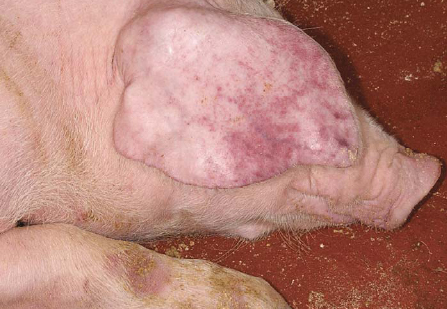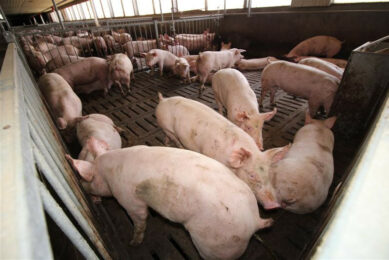African Swine Fever: Are we aware?

African Swine Fever, an infectious exotic pig disease, is becoming more and more famous in the European Union these days. What? Why? How? This article aims to answer these questions as well as some others related to the actual situation of the disease, its critical points, the potential risk of introduction into European Union and what can be done to prevent it.
African Swine Fever (ASF) is a viral disease, considered to be one of the most devastating diseases for swine herds. It is one of the seven listed pig diseases of the World Organization of Animal Health (OIE), due to its high transmission rate, the lack of a vaccine to protect susceptible populations, the severe symptoms in infected pigs and the devastating socio-economic consequences in the affected countries. It is a haemorrhagic disease that could cause different clinical signs, from hyperacute and acute forms with high mortality rates, similar to Classical Swine Fever or Erysipelas – to an asymptomatic or chronic presentation.
Epidemiology
ASF was discovered in Kenya, in 1921 by Montgomery. Since then, it is known to have been present in many sub-Saharan countries as an endemic disease.However, ASFV has not been restricted to Africa; from the 1960s until the 1980s several outbreaks were notified in some European, Central- and South American countries. Since 1995, ASF was restricted to Sub-Saharan countries and the Italian island of Sardinia, where ASF has been present since 1978. However, the presence of ASF in this island seems not to pose a high risk for EU, as during all this time the disease has only escaped out of the island once, producing an outbreak in northern Italy in 1983. For that reason, since the 1990s, ASF has been considered again as an exotic disease, restricted to African territories, and with relatively low risk to the European and American pig sector, so producers stopped worrying about it.
However, in 2007, this peaceful situation changed considerably, when ASFV was reintroduced in the eastern part of the European continent, this time in Georgia, probably associated with contaminated food waste entered by the port of Poti. From this first introduction into the Caucasus region, disease quickly spread to neighbouring countries (Armenia, Azerbaijan and, finally, the Russian Federation) causing huge economic losses in those affected countries.
Situation
Currently, the situation in the Caucasus region is out of control. New outbreaks are reported every month by Russian Federation authorities. Neighbouring countries like Georgia and Armenia have stopped reporting the disease two years ago (with few exceptions done by Armenia in 2010 and
2011), and no official information is available about the situation there. Unfortunately, ASFV is moving fast within the Russian territories reaching some important pig producing areas and with new notified outbreaks quite a distance from the original ones. National and regional administrations are trying to stop and control the disease spread. The presence, however, of some important factors, make ASF control critically difficult in this area.
Some of these factors include:
1. The lack of a coordinated and unified control programme in all Russian territories, with significant divergences among regions;
2. Illegal movements of pigs and pig products within the Russian Federation and;
3. The low biosecurity level of pig production systems in the area, especially in back-yard and free range pig farms, where swill feeding is still a common practice. Nowadays, only acute forms of the disease have been shown in the affected countries in eastern Europe. This situation leads to negative consequences as it results in higher economic losses. On the up side, this has allowed early detection and notification of the disease, as acute forms of the disease are easier to detect by farmers and veterinarians, compared to other known cases.
Transmission
ASFV is transmitted not only by direct contact between susceptible pigs and excretions of infected animals, especially with blood (where ASFV is present in high loads, for long periods of time), but also by indirect transmission through infected meat, pig products or by infected soft ticks. ASFV is able to infect all breeds and ages of domestic pigs; wild boars and other wild suids such as warthogs and bushpigs in south and east Africa; and soft ticks of genus Ornithodoros. These ticks play an important role in ASF transmission and maintenance in Africa, where a sylvatic cycle is established between wild suids and infected ticks, and ASFV persists for long periods of time.
Also in Europe, ticks from O. erraticus species are demonstrated to be present in certain areas, specifically in southern Europe. Historical reports reveal that swill feeding has been one of the most frequent ways for ASFV introduction into free countries. ASFV has been highly -resistant in the environment and infected materials, such as infected meat or pork products produced with infected pigs. In certain conditions, ASFV is able to resist 1,000 days in frozen meat and more than 15 weeks in putrefied blood stored at room temperature, the European Food Safety (EFSA) showed in 2009. This high resistance is responsible for the most common way of ASFV introduction into free areas by contaminated pig products.
Indeed, this was the way of ASFV entrance in Portugal, Cuba, the Netherlands and more recently, Georgia, among others. Food waste containing infected meat in certain countries is still used to feed pigs, implying high risk for disease transmission.
Risk of ASF into the EU
Considering the actual situation of ASF in the world, where ASFV is spreading rapidly and without control in many Sub-Saharan countries, the Russian Federation and the Trans Caucasus region, governments and pig sectors of ASF-free territories must be aware of the potential risk of ASFV introduction. They should be aware that in our global world, with such a frequent, rapid and distant interchange of animals and commodities, pathogens such as ASFV can be easily and quickly transmitted.
The EU is quite concerned about the risk imposed from the uncontrolled situation in the Russian Federation, particularly after the occurrence of several ASF outbreaks during last year in some areas very close to EU borders. For that reason, several studies and new legislation have been developed since 2007, including the ASFRISK research project and scientific advises from the EFSA in 2009 and 2010. Once ASF is detected and notified to the OIE, an immediate ban on exports of pigs and their products is applied. ASFV introduction by legal import of animals or products from Russia is nowadays impossible as these movements are forbidden. Moreover, even before ASF was notified in Russia, pig exports to certain countries, including EU members, were not allowed.However, ASFV could still be transmitted to the EU, by other possible routes of introduction like illegal imports of pig and pig products, entrance of contaminated vehicles, or even by movement of infected wild boars. All these routes of introduction and their importance in all EU state members has been considered and evaluated within the European research project ASFRISK. Results of this risk assessment have identified the most risky routes for a potential ASFV introduction in each EU country. These methods will provide a tool to administrations for preventing and controlling potential incursions of ASF into the EU.
Current situation
The current situation of ASF in the world requires that all actors (i.e. pig sector, administrations, policy makers, veterinarians, etc.) must be implicated and directly collaborate in the prevention and control of the disease. In order to act adequately, it is required that they receive appropriate and updated information about the current situation of ASF and the potential risk of its introduction into EU. All farmers and veterinarians must be aware of the clinical signs of acute forms of ASF that can be found in their pigs (high mortality, fever, haemorrhagic symptoms, cyanosis and petechias in the skin, anorexia and incoordination), and conveniently notify the authorities if they recognise them or are suspicious of the disease. Early detection is crucial; therefore, rapid field detection, immediate notification, correct sampling and effective implementation of control measures must occur and all the participants must be trained.
ASF preventive measures are based on the impediment of the entrance of the virus on free-regions by correct disposal of all waste from international boats and planes (which is mandatory within EU), enhancing border inspection controls, banning of swill feeding and training activities such as informative campaigns or simulation exercises for the awareness of farmers and veterinarians. Once the disease enters into a country, control measures include movement restrictions, culling of all affected animals and adequate disposal and destruction of carcasses. The international pig industry should be aware that those preventive and control measures are crucial as there is no vaccine available to prevent ASFV infection (and there is no sign of obtaining it in the coming years) and there is no effective treatment to palliate symptoms in the infected animals.
Conclusion
ASF is a complex disease affecting not only domestic pigs, but also wild suids and soft ticks. ASF virus is quite resistant in pig products and the environment, and there is no vaccine available to prevent the infection in susceptible populations. Its current presence in certain areas close to EU borders implies a risk to the pig sector in free-territories and all actors (farmers, private and official veterinarians, administrations and politicians) must be well trained and prepared to effectively prevent and control ASF. Certainly, the pig sector and the economy of many countries and regions is at stake here. PP References available on request.
What is the risk of ASF in the EU? Legal imports of live pigs from ASF-affected areas is completely forbidden – but what if this would be the pathway of infection? Where and when would this outbreak be likely to happen? A model, run by Mur and others (2011) indicated that the probability for ASFV due to legal imports approximately corresponds with one outbreak in 192 years. Considering this is a low risk, the country that poses the highest risk for ASFV introduction by this route is Poland, followed by Lithuania. This risk is mainly concentrated during the months of November and April, due to the seasonal changes registered in live pigs trade. The risk calculated was made using the 27 EU members as destination countries, and as origin countries, the countries from where imports of live pigs were registered from 2005 to 2009 in official European databases (Traces and Eurostat). |











